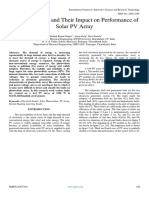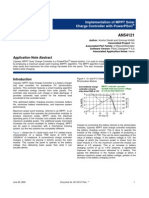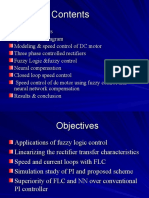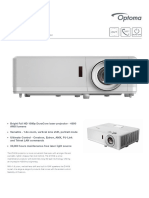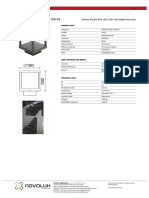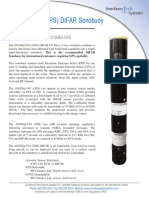Automatic Power Factor Controller
Automatic Power Factor Controller
Volume 9, Issue 4, April – 2024 International Journal of Innovative Science and Research Technology
ISSN No:-2456-2165 https://doi.org/10.38124/ijisrt/IJISRT24APR537
Automatic Power Factor Controller
1
Swati Haridas Bhure; 2J. R. Rana
1
M.Tech student; 2Professor
Department of Electrical Power System
Jawaharlal Nehru Engineering College, Chhatrapati Sambhajinagar
Abstract:- Automatic Power Factor Controllers The automatic Power factor controller Panel maintains
(APFCs) play a crucial role in modern electrical systems the power factor unity of the system. It will
by ensuring efficient electrical power and improving automatically switch on the capacitance and feed the
power quality. This paper presents a comprehensive reactive power to the system as per the required value.
overview of the Design, implementation, and
performance analysis of an APFC system. The proposed The main objective of our project is to design and
APFC system employs advanced control techniques to construct a contactor-based system that will help us find
regulate the power factor of the electrical load, thereby power factors automatically. A dip in the Power Factor can
minimizing reactive power consumption and optimizing attract operational losses and a penalty from the electricity
overall system efficiency. The design process board responsible for the electricity supply. APFC Panels
encompasses the selection of suitable power electronics can effectively and automatically manage quickly changing
converters, control algorithms, and sensing techniques and scattered loads along with the retention of high Power
tailored to the requirements of an application. The Factor. The target is to design and develop an APFC panel
results demonstrate significant improvements in power that handles the task described.
quality, energy utilization, and system stability, thereby
highlighting the practical relevance and applicability of II. LITERATURE REVIEW
the developed APFC technology.
The data is survey to receive basic ideas and
Keywords:- Automatic Power Factor Controller (APFC), knowledge of the project topic, Automatic Power Factor
Power Factor, Current Transformer, Circuit Breaker, Controller Panel (APFC Panel).
Sensors, Display Unit, Load Bank, Power Supply, PCB,
Microcontroller. StandardPublication International Journal of
Innovations in Engineering Research and Technology
I. INTRODUCTION [IJIERT] ISSN: 2394-3696 Volume 2, Issue 5, May
2015, the topic of Automatic Power Factor Correction
The power factor is the ratio between the Kw and the published by Gopal Reddy K. This paper presents the
KVA drawn by an electrical load where the Kw is the actual control to correct the power factor automatically
load power, and Kva is the apparent load power. It counts without any human presence. It automatically increases
how effectively the current converts into functional work and decreases in power factor. It also helps the
output of the individual indicator of the load current on the industries to continue even during peak hours. Different
efficiency of the supply system. In an organization, most of parts of the power factor contain the ripple current.
the load is inductive load. The result is a lagging power The International Journal of Engineering Trends and
factor loss and wastage of energy. Which results in high Technology (IJETT) on the topic of“Power Factor
power bills and heavy penalties from electricity boards. If Improvement using dual Boost Converter” The author
the load is uneven, it is hard to maintain the unity power published by Prof. D. D. Ahire.The paper involves
factor. To overcome APFC, use a panel that maintains a simulation of power electronics analysis of the current
unity power factor. So, in industries, they require automatic and voltage waveforms. The Apfc incorporated a
power factor control systems. Automatic power factor breaker switch capacitor bank into a small design using
control system, used for the enhancement of power factor. a low-cost sensing element and an intelligent control
The power factor proportion is called active power to device. The device provided more accurate voltage
apparent power. And the critical factor in measuring control and power factor correction than traditional
electrical consumption. Everyone knows how costly shunt capacitor bank installation.
electricity has become in the present time. The International Journal of Advance Research and
Innovative Ideas in Education on the topic of
A. Objectives "Automatic Power Factor control using Arduino UNO"
was published by Prof. Kunal Shah.This paper presents
Aim of the Project: a Contactor-based APFC system that can sustain up to
the rating of 20-25 Kva of the industrial load. The
The project aims to design and build a panel system that model will serve the purpose of the variation in power
defines the control power factor of the system. factor and automatically use the matching KVAr.
Shuffling presents an intelligent power factor
IJISRT24APR537 www.ijisrt.com 669
Volume 9, Issue 4, April – 2024 International Journal of Innovative Science and Research Technology
ISSN No:-2456-2165 https://doi.org/10.38124/ijisrt/IJISRT24APR537
compensator that performs the power factor correction
without existing harmonic resonance under varying
demand conditions.
In the International Journal of Advance
Research(IJAR). The topic of"Automatic power factor
correction and monitoring by using microcontrollers"
was published byAparna Sarkar and Umesh Hi wase.
The topic of this paper is an advanced method of power
factor correction that utilizes a microcontroller. As
switching of capacitors is done automatically, we get
better accurate results of power factor control
techniques that make the system stable, and that
improves power factor efficiency also increases. The
compensator in a power electronic system operating
with poor service power factor can be controlled vector-
wise by phase and quadrature components of the supply
current.
The International Journal of Innovations in
EngineeringResearch and Technology(IJIERT). The
topic of Design and simulation of an activepower factor
controller using "Boost Converter" was published by
Sujata Nazarkar.The decoupling allows for more control
freedom by utilizing a freewheeling interval. Current
stress was increased by reducing inductor-current ripple
and improving current handling capability at heavy
loads, demonstrating a fast transient response. Boost
PFC converter is much simpler and has better dynamic Fig 2: Circuit Design
performance than the PCCM boost PFC converter
against load disturbance while maintaining low input- This diagram illustrates the main components of an
current distortion. APFC system:
III. METHODOLOGY
Voltage Sensor (V sense): Measures the voltage across
the load.
Current Sensor (I sense): Measures the current
flowing through the load.
Comparator (Error Amp): Compares the actual power
factor with the desired setpoint and generates an error
signal.
Controller: Receives the error signal and determines
the appropriate corrective action using control
algorithms such as PID, fuzzy logic, or adaptive control.
Power Electronics Converters: Modify the reactive
power delivered to the load by the controller control
signals.
Load: This represents the electrical load, which 1q may
be inductive, capacitive, or resistive.
IV. PROPOSED METHODOLOGY
The controller can receive two signals (voltage and
current) from the line when using a current transformer.
The power factor is low when the load is inductive.
The current is behind the voltage by a significant angle
because of the low power factor. The controller
calculates the phase angle between these two signals by
measuring the time interval with a timer. The controller
calculates the power factor by formula (Cos X phase
angle). After that, it calculates the required
compensation.
Fig 1: Block Diagram Of APFC
IJISRT24APR537 www.ijisrt.com 670
Volume 9, Issue 4, April – 2024 International Journal of Innovative Science and Research Technology
ISSN No:-2456-2165 https://doi.org/10.38124/ijisrt/IJISRT24APR537
The controller acts as the brain of the circuit; it Capacitor Bank Design:
performs all the mathematical operations.
When the difference is detected, the controller closes Design the capacitor bank to provide the required
the contactors, which act as a switch between the reactive power compensation. Determine the number of
capacitor and the supply. capacitor stages and their ratings based on load
Required capacitors are added to the system to improve variations and power factor correction needs.
the power factor of the load.
Adding capacitors results in an increase in the power Control Strategy Development:
factor to the desired value.
The controller panel display shows the improved Power Develop control algorithms to continuously monitor the
factor. power factor and activate/deactivate capacitor stages
Disconnecting the capacitor from the load side and accordingly.
discharging the remaining charge into the resistor Implement strategies to prevent rapid switching and
occurs when the power factor is improved. minimize wear on the switching devices.
Failure to discharge the capacitor may result in damage
and shock. Safety Features Implementation:
V. SYSTEM DEVELOPMENT To ensure system components are safe, include safety
features such as overcurrent protection, overvoltage
Requirement Analysis: protection, and short-circuit protection.
Understand the power consumption patterns and Testing and Validation:
requirements of the electrical system.
Determine the target power factor and reactive power Conduct comprehensive testing of the APFC system
compensation needed to improve power efficiency. under various operating conditions and load scenarios.
Identify the types of loads and their varying power Check the accuracy of sensor readings, the efficiency of
factor characteristics. control algorithms, and the reliability of switching
operations
System Design: Perform testing in simulated environments and real-
world conditions to validate system performance.
Consider voltage levels, load types, and system capacity
when designing the APFC system architecture. Installation and Commissioning:
Choose the suitable components, like capacitors,
reactors, contactors, and controllers, according to the Install the APFC system at the intended location in the
system requirements. electrical distribution network.
Design the control algorithm for automatic adjustment Configure controller settings, calibrate sensors and
of power factor correction. verify proper operation.
Trained personnel on how to operate, maintain, and
Controller Selection: troubleshoot systems.
Choose a suitable controller that can monitor the power Maintenance and Support:
factor in real time and control the switching of
capacitors accordingly. Establish a maintenance schedule for routine inspection,
Consider controllers with features like digital signal calibration, and servicing of the APFC system.
processing, communication interfaces, and protection Provide ongoing support to address any issues or
mechanisms. optimize system performance as needed.
Sensor Integration: VI. CONCLUSION
Integrate sensors such as voltage and current From our Project, We Observed that this APFC Panel
transformers or transducers to measure parameters like will Help us in Finding
voltage, current, and power factor.
Effective control requires accurate and reliable sensor Raising the power factor has been proven to help
readings. utilities and end users use electricity more efficiently.
It reduces the consumer's electricity bills.
It also helps to reduce the cable size and circuit breaker
size.
It can concluded that the power factor correction
technique can be applied to industries, power systems,
and households to ensure their stability, resulting in the
IJISRT24APR537 www.ijisrt.com 671
Volume 9, Issue 4, April – 2024 International Journal of Innovative Science and Research Technology
ISSN No:-2456-2165 https://doi.org/10.38124/ijisrt/IJISRT24APR537
system becoming stable and the efficiency of the
systems and apparatus increasing. If the compensator
rating is less than the load observed by the detected
power, it will improve the power given by the AC
supply and reduce the power consumption. Better power
quality is achieved by reducing the apparent power
drawn from the AC supply and minimizing the power
transmission losses. Hence, the efficiency of both the
systems and apparatus increases.
REFERENCES
[1]. Buso S, Matta Villi P, Rosette L and Spiazzi G
(2006) "Simple digital control improving the
dynamic performance of power factor pre
regulators," IEEE Trans. Power Electronics, issue 5,
Vol. 13, pp. 814-823.
[2]. Gusseme K and. Melkebeek J. (2002) "Design
issues for digital control of boost power factor
converters," IEEE International Symposium on
Industrial Electronics.
[3]. Fu M and Chen O): "A DSP-based controller for
power factor correction(PFC) in a rectifier circuit,"
IEEE Applied Power Electronics Conference,
(2012).
[4]. Feng Y.T, Tsai G.L, and Tzou AC/DC converter with
fast YY Digital control of a single-stage single-
switch flyback PFC Vol. 2, pp. 1251-1256. (2009):
response," IEEE Power Electronics Specialists
Conference, TECHNOL of ElecNE CAMPUS
SWPANV
[5]. Rao U M, Vijaya M A, Venakata S S, Williams T J,
Butter N G, -An Adaptive Power Factor Controller
For 3 Phase Induction Generations], IEEE
Transaction on Power Apparatus and Systems 2012
[6]. Mr. Musthafa. P, Mr. M. Sivasubramanian, Mr.K.
Sakthidhasan, -Analysis of Dynamic Power Factor
Correction Using Flexible Ac Transmission Systems
[7]. Jones, L. D.; Blackwell, D. -Energy Saver Power
Factor Controller for Induction Motors IEEE (1983).
[8]. Rakendu Mandal Sanjoy Kumar Basu; Asim Kar;
Shyama Pada Chowdhury-A Microcomputer –
Based Power Factor Controller, IEEE Transactions
on Industrial Electronics (1994).
[9]. Edris, R. Adapa, M. H. Baker, L. Bohmann, K.
Clark, K. Habashi, L. Gyugyi, J. Lemay, A.S.
Mehraban, A.K. Myers, J. Reeve, F. Sener,
D.R.Torgerson, R.R. Wood, "Proposed Terms and
Definitions for Flexible Ac Transmission System
(FACTS)", IEEE Trans. Power Delivery, Vol. 12,
No.4, pp. 1848-1853 .
[10]. K.R. Padiyar, Analysis of Subsynchronous
Resonance in Power Systems, Kluwer Academic
Publishers, Boston.
IJISRT24APR537 www.ijisrt.com 672
You might also like
- Service Manual Chassis TPM19.1E LA MTK5599 Philips100% (1)Service Manual Chassis TPM19.1E LA MTK5599 Philips94 pages
- Simulation of Some Power System, Control System and Power Electronics Case Studies Using Matlab and PowerWorld SimulatorFrom EverandSimulation of Some Power System, Control System and Power Electronics Case Studies Using Matlab and PowerWorld SimulatorNo ratings yet
- A Case Study for a Single-Phase Inverter Photovoltaic System of a Three-Bedroom Apartment Located in Alexandria, Egypt: building industry, #0From EverandA Case Study for a Single-Phase Inverter Photovoltaic System of a Three-Bedroom Apartment Located in Alexandria, Egypt: building industry, #0No ratings yet
- Investigation of the Usefulness of the PowerWorld Simulator Program: Developed by "Glover, Overbye & Sarma" in the Solution of Power System ProblemsFrom EverandInvestigation of the Usefulness of the PowerWorld Simulator Program: Developed by "Glover, Overbye & Sarma" in the Solution of Power System ProblemsNo ratings yet
- Integration of Green and Renewable Energy in Electric Power SystemsFrom EverandIntegration of Green and Renewable Energy in Electric Power SystemsNo ratings yet
- Automatic Power Factor Correction: Project Presentation On100% (1)Automatic Power Factor Correction: Project Presentation On23 pages
- Chapter-1: 1.1.1 The Principle of WindmillNo ratings yetChapter-1: 1.1.1 The Principle of Windmill22 pages
- Automatic Grid Failure Detection and ControlNo ratings yetAutomatic Grid Failure Detection and Control26 pages
- Design Optimization and Performance Evaluation of Grid Connected Solar Photovoltaic SystemsNo ratings yetDesign Optimization and Performance Evaluation of Grid Connected Solar Photovoltaic Systems72 pages
- Microcontroller Based Three Phase InverterNo ratings yetMicrocontroller Based Three Phase Inverter4 pages
- (Project) INTEGRATION OF SOLAR PV INTO GRIDNo ratings yet(Project) INTEGRATION OF SOLAR PV INTO GRID13 pages
- DSGW-030 Smart Gateway S Serial-Spec v5.0No ratings yetDSGW-030 Smart Gateway S Serial-Spec v5.020 pages
- Electrical Faults and Their Impact On Performance of Solar PV ArrayNo ratings yetElectrical Faults and Their Impact On Performance of Solar PV Array7 pages
- Modeling and Control of Isolated Micro-Hydro Power Plant With Battery Storage SystemNo ratings yetModeling and Control of Isolated Micro-Hydro Power Plant With Battery Storage System7 pages
- MAXIMUM POWER POINT TRACKING SYSTEM of Solar Panel75% (4)MAXIMUM POWER POINT TRACKING SYSTEM of Solar Panel149 pages
- Application Note Abstract: Implementation of MPPT Solar Charge Controller With PowerpsocNo ratings yetApplication Note Abstract: Implementation of MPPT Solar Charge Controller With Powerpsoc14 pages
- Design and Construction of 1KW 1000VA Po PDFNo ratings yetDesign and Construction of 1KW 1000VA Po PDF14 pages
- MPPT Based Optimal Charge Controller in PV System100% (2)MPPT Based Optimal Charge Controller in PV System37 pages
- Eee-Viii-power System Operation and Control (06ee82) - Notes100% (3)Eee-Viii-power System Operation and Control (06ee82) - Notes138 pages
- Power System Deregulation - SVEC-19 - M.techNo ratings yetPower System Deregulation - SVEC-19 - M.tech2 pages
- Phase Balancing Using Genetic Algorithm: ExampleNo ratings yetPhase Balancing Using Genetic Algorithm: Example3 pages
- Transformer: Professor Mohamed A. El-SharkawiNo ratings yetTransformer: Professor Mohamed A. El-Sharkawi87 pages
- Switching Power Supply Circuit Diagram With Explanation: Catalog100% (1)Switching Power Supply Circuit Diagram With Explanation: Catalog22 pages
- DC-DC Converter Fault (Important Paper)No ratings yetDC-DC Converter Fault (Important Paper)16 pages
- Control of Hybrid AC DC Micro Grid Involving Energy Storage, Renewable Energy and Pulsed LoadsNo ratings yetControl of Hybrid AC DC Micro Grid Involving Energy Storage, Renewable Energy and Pulsed Loads8 pages
- MPPT Based PV System For Partial ShadingNo ratings yetMPPT Based PV System For Partial Shading73 pages
- Optimization of Hybrid Power Systems Using Homer: Mini Project ReportNo ratings yetOptimization of Hybrid Power Systems Using Homer: Mini Project Report18 pages
- A Matlab / Simulink Based Tool For Power Electronic CircuitsNo ratings yetA Matlab / Simulink Based Tool For Power Electronic Circuits6 pages
- Designing Residential Arrays in Helioscope: Application NoteNo ratings yetDesigning Residential Arrays in Helioscope: Application Note6 pages
- Backward Forward Sweep Load Flow Algorithm For Radial Distribution SystemNo ratings yetBackward Forward Sweep Load Flow Algorithm For Radial Distribution System3 pages
- Predictive Maintenance Practices of Induction Motor: V Venkatesh, D Vamsi Krishna, KV Kalyani, D K PandaNo ratings yetPredictive Maintenance Practices of Induction Motor: V Venkatesh, D Vamsi Krishna, KV Kalyani, D K Panda9 pages
- Epistemic Risks of Big Data Analytics in Scientific Discovery: Analysis of the Reliability and Biases of Inductive Reasoning in Large-Scale DatasetsNo ratings yetEpistemic Risks of Big Data Analytics in Scientific Discovery: Analysis of the Reliability and Biases of Inductive Reasoning in Large-Scale Datasets7 pages
- The Digital Influence ChatGPT and its Role in Shaping Youth Cognitive Processes and Decision-MakingNo ratings yetThe Digital Influence ChatGPT and its Role in Shaping Youth Cognitive Processes and Decision-Making5 pages
- To Compare the Effectiveness of Jacobson’s Relaxation Techniques and Mitchell’s Relaxation Techniques along with Diaphragmatic Breathing on Insomnia in Elderly IndividualsNo ratings yetTo Compare the Effectiveness of Jacobson’s Relaxation Techniques and Mitchell’s Relaxation Techniques along with Diaphragmatic Breathing on Insomnia in Elderly Individuals9 pages
- Influence of Age, Gender, Socioeconomic Status, and Education Level on Glycemic Control in Diabetic Patients Attending Kapkatet Sub-County Hospital, Kericho County, KenyaNo ratings yetInfluence of Age, Gender, Socioeconomic Status, and Education Level on Glycemic Control in Diabetic Patients Attending Kapkatet Sub-County Hospital, Kericho County, Kenya9 pages
- Bridging the Digital Divide in Agriculture: Lessons from the United States and Africa in Smart Farming AdoptionNo ratings yetBridging the Digital Divide in Agriculture: Lessons from the United States and Africa in Smart Farming Adoption10 pages
- A Comparative Analysis of Natural Language Processing Models: BERT and LSTM in Enhancing Business CommunicationNo ratings yetA Comparative Analysis of Natural Language Processing Models: BERT and LSTM in Enhancing Business Communication6 pages
- From Visualization to Purchase: How Augmented Reality (AR), Virtual Reality (VR) and Artificial Intelligence (AI) Influence Consumer Purchase Decisions in Housing Design DecisionsNo ratings yetFrom Visualization to Purchase: How Augmented Reality (AR), Virtual Reality (VR) and Artificial Intelligence (AI) Influence Consumer Purchase Decisions in Housing Design Decisions23 pages
- Case Study and Examination of Production Methods in a Steel Manufacturing FacilityNo ratings yetCase Study and Examination of Production Methods in a Steel Manufacturing Facility7 pages
- Impact of Storytelling and Emotional Branding on Consumer Purchase Behavior in Quick Service Restaurants and FMCGNo ratings yetImpact of Storytelling and Emotional Branding on Consumer Purchase Behavior in Quick Service Restaurants and FMCG15 pages
- Comparing the Effect of Ashoka Ointment and Herjet OintmentNo ratings yetComparing the Effect of Ashoka Ointment and Herjet Ointment5 pages
- AI-Driven Predictive Analytics for Syndromic Surveillance: Enhancing Early Detection of Emerging Infectious Diseases in the United StatesNo ratings yetAI-Driven Predictive Analytics for Syndromic Surveillance: Enhancing Early Detection of Emerging Infectious Diseases in the United States8 pages
- Geriatric Medication Management Using STOPP/START Criteria on Polypharmacy in a Multicentre Hospital: A Systematic ReviewNo ratings yetGeriatric Medication Management Using STOPP/START Criteria on Polypharmacy in a Multicentre Hospital: A Systematic Review6 pages
- Remarkable Spatial Influences behind Shaping the Bangla Dance: Performer and Audience PerspectivesNo ratings yetRemarkable Spatial Influences behind Shaping the Bangla Dance: Performer and Audience Perspectives8 pages
- Psychological Well-being among Tribal and Non-Tribal B.Ed. StudentsNo ratings yetPsychological Well-being among Tribal and Non-Tribal B.Ed. Students4 pages
- Affirmative Policy on Belis in Marriage Traditions at Family Institutions in the Abenaho District of PapuaNo ratings yetAffirmative Policy on Belis in Marriage Traditions at Family Institutions in the Abenaho District of Papua14 pages
- Synergizing Renewables with Power Grid: A Path towards Stability and SustainabilityNo ratings yetSynergizing Renewables with Power Grid: A Path towards Stability and Sustainability5 pages
- Library Personnel’s Career Development and Job Performance of the National UniversityNo ratings yetLibrary Personnel’s Career Development and Job Performance of the National University8 pages
- Autonomous Obstacle Avoiding and Pesticide Spraying Robot for Smart FarmingNo ratings yetAutonomous Obstacle Avoiding and Pesticide Spraying Robot for Smart Farming4 pages
- Factors Influencing the Organizational Performance of Hotel EstablishmentsNo ratings yetFactors Influencing the Organizational Performance of Hotel Establishments12 pages
- An Integrated Web Application for Campus Life: A Digital Solution for Learning and VotingNo ratings yetAn Integrated Web Application for Campus Life: A Digital Solution for Learning and Voting8 pages
- Structural Equation Modeling of Students’ Performance in Pre-Calculus: Basis for Intervention in Senior High School100% (1)Structural Equation Modeling of Students’ Performance in Pre-Calculus: Basis for Intervention in Senior High School12 pages
- Citizen Satisfaction with Electronic-Government Services: A Case Study of Huduma Centre MombasaNo ratings yetCitizen Satisfaction with Electronic-Government Services: A Case Study of Huduma Centre Mombasa13 pages
- Leveraging Digital Surveillance Technologies for Managing Border Porosity and Enhancing Revenue Collection in KenyaNo ratings yetLeveraging Digital Surveillance Technologies for Managing Border Porosity and Enhancing Revenue Collection in Kenya11 pages
- Leveraging Wi-Fi-Based Tracking for Enhanced Conference Management and Exhibitor ValueNo ratings yetLeveraging Wi-Fi-Based Tracking for Enhanced Conference Management and Exhibitor Value11 pages
- Precision, Prediction and Progress: A New Era in PharmacologyNo ratings yetPrecision, Prediction and Progress: A New Era in Pharmacology23 pages
- Mobile Phone Detector: Components RequiredNo ratings yetMobile Phone Detector: Components Required9 pages
- SLD of Solar Park Pooling SS R1 121111 (2) - Model (1) .pdfBIRENNo ratings yetSLD of Solar Park Pooling SS R1 121111 (2) - Model (1) .pdfBIREN1 page
- IET Power Electronics - 2019 - Bosso - Isolated Bidirectional DC To Three Phase AC Converter For Integration of RenewableNo ratings yetIET Power Electronics - 2019 - Bosso - Isolated Bidirectional DC To Three Phase AC Converter For Integration of Renewable11 pages
- TCF-142 Quick Installation Guide: Edition 16.0, March 2019No ratings yetTCF-142 Quick Installation Guide: Edition 16.0, March 20198 pages
- Computer System Architecture - Morris ManoNo ratings yetComputer System Architecture - Morris Mano261 pages
- Design and Implement of A Programmable Logic Controller (PLC) For Classical Control LaboratoryNo ratings yetDesign and Implement of A Programmable Logic Controller (PLC) For Classical Control Laboratory6 pages
- DS-72xx Series Embedded Net DVR User'S Manual: Downloaded From Manuals Search EngineNo ratings yetDS-72xx Series Embedded Net DVR User'S Manual: Downloaded From Manuals Search Engine73 pages
- Arlen: Bollard ARLEN IP54 LED COB 12W 3000K AnthraciteNo ratings yetArlen: Bollard ARLEN IP54 LED COB 12W 3000K Anthracite2 pages
- Detector Inundação Carel Referência Rápida PDFNo ratings yetDetector Inundação Carel Referência Rápida PDF2 pages
- ZXD3000 V6.0R03 Rectifier Datasheet V2.1 - 20201117 - ENNo ratings yetZXD3000 V6.0R03 Rectifier Datasheet V2.1 - 20201117 - EN6 pages
- Service Manual Chassis TPM19.1E LA MTK5599 PhilipsService Manual Chassis TPM19.1E LA MTK5599 Philips
- Simulation of Some Power System, Control System and Power Electronics Case Studies Using Matlab and PowerWorld SimulatorFrom EverandSimulation of Some Power System, Control System and Power Electronics Case Studies Using Matlab and PowerWorld Simulator
- A Case Study for a Single-Phase Inverter Photovoltaic System of a Three-Bedroom Apartment Located in Alexandria, Egypt: building industry, #0From EverandA Case Study for a Single-Phase Inverter Photovoltaic System of a Three-Bedroom Apartment Located in Alexandria, Egypt: building industry, #0
- Investigation of the Usefulness of the PowerWorld Simulator Program: Developed by "Glover, Overbye & Sarma" in the Solution of Power System ProblemsFrom EverandInvestigation of the Usefulness of the PowerWorld Simulator Program: Developed by "Glover, Overbye & Sarma" in the Solution of Power System Problems
- Integration of Green and Renewable Energy in Electric Power SystemsFrom EverandIntegration of Green and Renewable Energy in Electric Power Systems
- Computer Methods in Power Systems Analysis with MATLABFrom EverandComputer Methods in Power Systems Analysis with MATLAB
- Automatic Power Factor Correction: Project Presentation OnAutomatic Power Factor Correction: Project Presentation On
- Design Optimization and Performance Evaluation of Grid Connected Solar Photovoltaic SystemsDesign Optimization and Performance Evaluation of Grid Connected Solar Photovoltaic Systems
- Electrical Faults and Their Impact On Performance of Solar PV ArrayElectrical Faults and Their Impact On Performance of Solar PV Array
- Modeling and Control of Isolated Micro-Hydro Power Plant With Battery Storage SystemModeling and Control of Isolated Micro-Hydro Power Plant With Battery Storage System
- MAXIMUM POWER POINT TRACKING SYSTEM of Solar PanelMAXIMUM POWER POINT TRACKING SYSTEM of Solar Panel
- Application Note Abstract: Implementation of MPPT Solar Charge Controller With PowerpsocApplication Note Abstract: Implementation of MPPT Solar Charge Controller With Powerpsoc
- Eee-Viii-power System Operation and Control (06ee82) - NotesEee-Viii-power System Operation and Control (06ee82) - Notes
- Switching Power Supply Circuit Diagram With Explanation: CatalogSwitching Power Supply Circuit Diagram With Explanation: Catalog
- Control of Hybrid AC DC Micro Grid Involving Energy Storage, Renewable Energy and Pulsed LoadsControl of Hybrid AC DC Micro Grid Involving Energy Storage, Renewable Energy and Pulsed Loads
- Optimization of Hybrid Power Systems Using Homer: Mini Project ReportOptimization of Hybrid Power Systems Using Homer: Mini Project Report
- A Matlab / Simulink Based Tool For Power Electronic CircuitsA Matlab / Simulink Based Tool For Power Electronic Circuits
- Designing Residential Arrays in Helioscope: Application NoteDesigning Residential Arrays in Helioscope: Application Note
- Backward Forward Sweep Load Flow Algorithm For Radial Distribution SystemBackward Forward Sweep Load Flow Algorithm For Radial Distribution System
- Predictive Maintenance Practices of Induction Motor: V Venkatesh, D Vamsi Krishna, KV Kalyani, D K PandaPredictive Maintenance Practices of Induction Motor: V Venkatesh, D Vamsi Krishna, KV Kalyani, D K Panda
- Epistemic Risks of Big Data Analytics in Scientific Discovery: Analysis of the Reliability and Biases of Inductive Reasoning in Large-Scale DatasetsEpistemic Risks of Big Data Analytics in Scientific Discovery: Analysis of the Reliability and Biases of Inductive Reasoning in Large-Scale Datasets
- The Digital Influence ChatGPT and its Role in Shaping Youth Cognitive Processes and Decision-MakingThe Digital Influence ChatGPT and its Role in Shaping Youth Cognitive Processes and Decision-Making
- To Compare the Effectiveness of Jacobson’s Relaxation Techniques and Mitchell’s Relaxation Techniques along with Diaphragmatic Breathing on Insomnia in Elderly IndividualsTo Compare the Effectiveness of Jacobson’s Relaxation Techniques and Mitchell’s Relaxation Techniques along with Diaphragmatic Breathing on Insomnia in Elderly Individuals
- Influence of Age, Gender, Socioeconomic Status, and Education Level on Glycemic Control in Diabetic Patients Attending Kapkatet Sub-County Hospital, Kericho County, KenyaInfluence of Age, Gender, Socioeconomic Status, and Education Level on Glycemic Control in Diabetic Patients Attending Kapkatet Sub-County Hospital, Kericho County, Kenya
- Bridging the Digital Divide in Agriculture: Lessons from the United States and Africa in Smart Farming AdoptionBridging the Digital Divide in Agriculture: Lessons from the United States and Africa in Smart Farming Adoption
- A Comparative Analysis of Natural Language Processing Models: BERT and LSTM in Enhancing Business CommunicationA Comparative Analysis of Natural Language Processing Models: BERT and LSTM in Enhancing Business Communication
- From Visualization to Purchase: How Augmented Reality (AR), Virtual Reality (VR) and Artificial Intelligence (AI) Influence Consumer Purchase Decisions in Housing Design DecisionsFrom Visualization to Purchase: How Augmented Reality (AR), Virtual Reality (VR) and Artificial Intelligence (AI) Influence Consumer Purchase Decisions in Housing Design Decisions
- Case Study and Examination of Production Methods in a Steel Manufacturing FacilityCase Study and Examination of Production Methods in a Steel Manufacturing Facility
- Impact of Storytelling and Emotional Branding on Consumer Purchase Behavior in Quick Service Restaurants and FMCGImpact of Storytelling and Emotional Branding on Consumer Purchase Behavior in Quick Service Restaurants and FMCG
- Comparing the Effect of Ashoka Ointment and Herjet OintmentComparing the Effect of Ashoka Ointment and Herjet Ointment
- AI-Driven Predictive Analytics for Syndromic Surveillance: Enhancing Early Detection of Emerging Infectious Diseases in the United StatesAI-Driven Predictive Analytics for Syndromic Surveillance: Enhancing Early Detection of Emerging Infectious Diseases in the United States
- Geriatric Medication Management Using STOPP/START Criteria on Polypharmacy in a Multicentre Hospital: A Systematic ReviewGeriatric Medication Management Using STOPP/START Criteria on Polypharmacy in a Multicentre Hospital: A Systematic Review
- Remarkable Spatial Influences behind Shaping the Bangla Dance: Performer and Audience PerspectivesRemarkable Spatial Influences behind Shaping the Bangla Dance: Performer and Audience Perspectives
- Psychological Well-being among Tribal and Non-Tribal B.Ed. StudentsPsychological Well-being among Tribal and Non-Tribal B.Ed. Students
- Affirmative Policy on Belis in Marriage Traditions at Family Institutions in the Abenaho District of PapuaAffirmative Policy on Belis in Marriage Traditions at Family Institutions in the Abenaho District of Papua
- Synergizing Renewables with Power Grid: A Path towards Stability and SustainabilitySynergizing Renewables with Power Grid: A Path towards Stability and Sustainability
- Library Personnel’s Career Development and Job Performance of the National UniversityLibrary Personnel’s Career Development and Job Performance of the National University
- Autonomous Obstacle Avoiding and Pesticide Spraying Robot for Smart FarmingAutonomous Obstacle Avoiding and Pesticide Spraying Robot for Smart Farming
- Factors Influencing the Organizational Performance of Hotel EstablishmentsFactors Influencing the Organizational Performance of Hotel Establishments
- An Integrated Web Application for Campus Life: A Digital Solution for Learning and VotingAn Integrated Web Application for Campus Life: A Digital Solution for Learning and Voting
- Structural Equation Modeling of Students’ Performance in Pre-Calculus: Basis for Intervention in Senior High SchoolStructural Equation Modeling of Students’ Performance in Pre-Calculus: Basis for Intervention in Senior High School
- Citizen Satisfaction with Electronic-Government Services: A Case Study of Huduma Centre MombasaCitizen Satisfaction with Electronic-Government Services: A Case Study of Huduma Centre Mombasa
- Leveraging Digital Surveillance Technologies for Managing Border Porosity and Enhancing Revenue Collection in KenyaLeveraging Digital Surveillance Technologies for Managing Border Porosity and Enhancing Revenue Collection in Kenya
- Leveraging Wi-Fi-Based Tracking for Enhanced Conference Management and Exhibitor ValueLeveraging Wi-Fi-Based Tracking for Enhanced Conference Management and Exhibitor Value
- Precision, Prediction and Progress: A New Era in PharmacologyPrecision, Prediction and Progress: A New Era in Pharmacology
- SLD of Solar Park Pooling SS R1 121111 (2) - Model (1) .pdfBIRENSLD of Solar Park Pooling SS R1 121111 (2) - Model (1) .pdfBIREN
- IET Power Electronics - 2019 - Bosso - Isolated Bidirectional DC To Three Phase AC Converter For Integration of RenewableIET Power Electronics - 2019 - Bosso - Isolated Bidirectional DC To Three Phase AC Converter For Integration of Renewable
- TCF-142 Quick Installation Guide: Edition 16.0, March 2019TCF-142 Quick Installation Guide: Edition 16.0, March 2019
- Design and Implement of A Programmable Logic Controller (PLC) For Classical Control LaboratoryDesign and Implement of A Programmable Logic Controller (PLC) For Classical Control Laboratory
- DS-72xx Series Embedded Net DVR User'S Manual: Downloaded From Manuals Search EngineDS-72xx Series Embedded Net DVR User'S Manual: Downloaded From Manuals Search Engine
- Arlen: Bollard ARLEN IP54 LED COB 12W 3000K AnthraciteArlen: Bollard ARLEN IP54 LED COB 12W 3000K Anthracite
- ZXD3000 V6.0R03 Rectifier Datasheet V2.1 - 20201117 - ENZXD3000 V6.0R03 Rectifier Datasheet V2.1 - 20201117 - EN
























